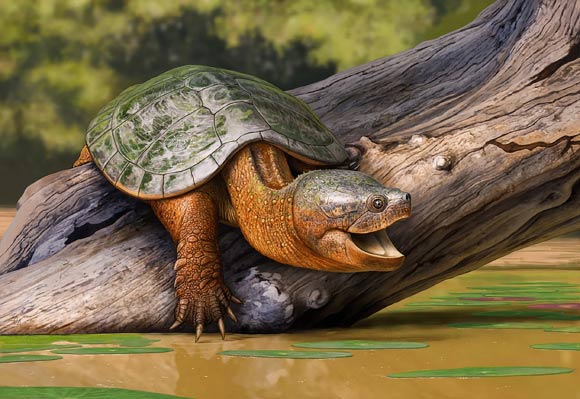Paleontologists have described a new genus and species of stem-chelydrid turtle using complete fossilized shells and associated material found in the Early Paleocene Denver Formation in Colorado.

A reconstruction of Tavachelydra stevensoni basking on a log in a ponded water environment. Image credit: Andrey Atuchin.
Tavachelydra stevensoni lived in what is now the United States during the earliest Paleocene epoch, between 66 and 65 million years ago — just after the end-Cretaceous mass extinction.
The species belongs to Chelydridae, a family of freshwater turtles that includes at least seven extinct and two living genera.
“The clade of extant chelydrid turtles (Chelydridae) includes five species that are endemic to the New World and whose combined geographic ranges extend from northern South America to southern Canada,” said Dr. Tyler Lyson from the Denver Museum of Nature & Science and his colleagues.
“While not a diverse clade, chelydrid turtles are a common component of most North American freshwater ecosystems.”
“The total group of chelydrids (i.e., Pan-Chelydridae) is found throughout Laurasia, but fossil remains are notoriously fragmentary.”
The fossilized carapaces and skulls of two Tavachelydra stevensoni individuals were found in the Corral Bluffs Study Area, which is located in El Paso County in south-central Colorado, east of Colorado Springs.
“With a straight carapace length of nearly 50 cm, Tavachelydra stevensoni is one of the larger turtles within the early Paleocene (Puercan) of the Denver Basin,” the paleontologists said.
“Interestingly, two pan-chelydrid turtles are present in the early Paleocene of Corral Bluffs, Tavachelydra stevensoni and Denverus middletoni.”
“The two differ significantly in size, with Tavachelydra stevensoni being at least four times larger than Denverus middletoni, which likely helped reduce competition between two chelydrids with overlapping geographic ranges.”
Little is known about the paleoenvironment of the single known specimen of Denverus middletoni, but the fine- to medium-grained mustard yellow sandstone in which it was found was initially interpreted to represent a channel infill.
The two partial Tavachelydra stevensoni skeletons, by contrast, were found near one another in a ponded water or distal crevasse splay deposit, so it is reasonable to infer that Tavachelydra stevensoni inhabited ponded water overbank deposits.
“While nothing can be said about the diet of Denverus middletoni as its skull is not preserved, Tavachelydra stevensoni had a large skull with broad, flat triturating surfaces indicative of a durophageous diet (eating behavior of animals that consume hard-shelled or exoskeleton-bearing organisms, such as corals, shelled mollusks, or crabs),” the researchers said.
“It therefore appears plausible that Denverus middletoni and Tavachelydra stevensoni occupied different ecological niches, with Tavachelydra stevensoni preferring ponded environments and a durophagous diet.”
“Interestingly, turtle species with a durophageous diet have a higher survivorship across the end-Cretaceous mass extinction compared to turtles with a non-durophageous diet.”
“In addition to the inferred durophagous dietary preferences of Tavachelydra stevensoni, several of the more common reptiles described from Corral Bluffs are also interpreted to be durophagous, including the button-toothed crocodylian cf. Wannaganosuchus, and the baenid turtles Palatobaena knellerorum, Saxochelys gilberti, and Cedrobaena putorius.”
“This suggests durophagy was an important life-history trait for freshwater vertebrates during the earliest Paleocene of North America.”
The discovery of Tavachelydra stevensoni is described in a paper published in the journal Swiss Journal of Palaeontology.
_____
T.R. Lyson et al. 2025. A new pan-chelydrid turtle, Tavachelydra stevensoni gen. et sp. nov., from the lower Paleocene (early Danian, Puercan) Corral Bluffs Study Area in the Denver Basin, Colorado. Swiss J Palaeontol 144, 46; doi: 10.1186/s13358-025-00375-4







